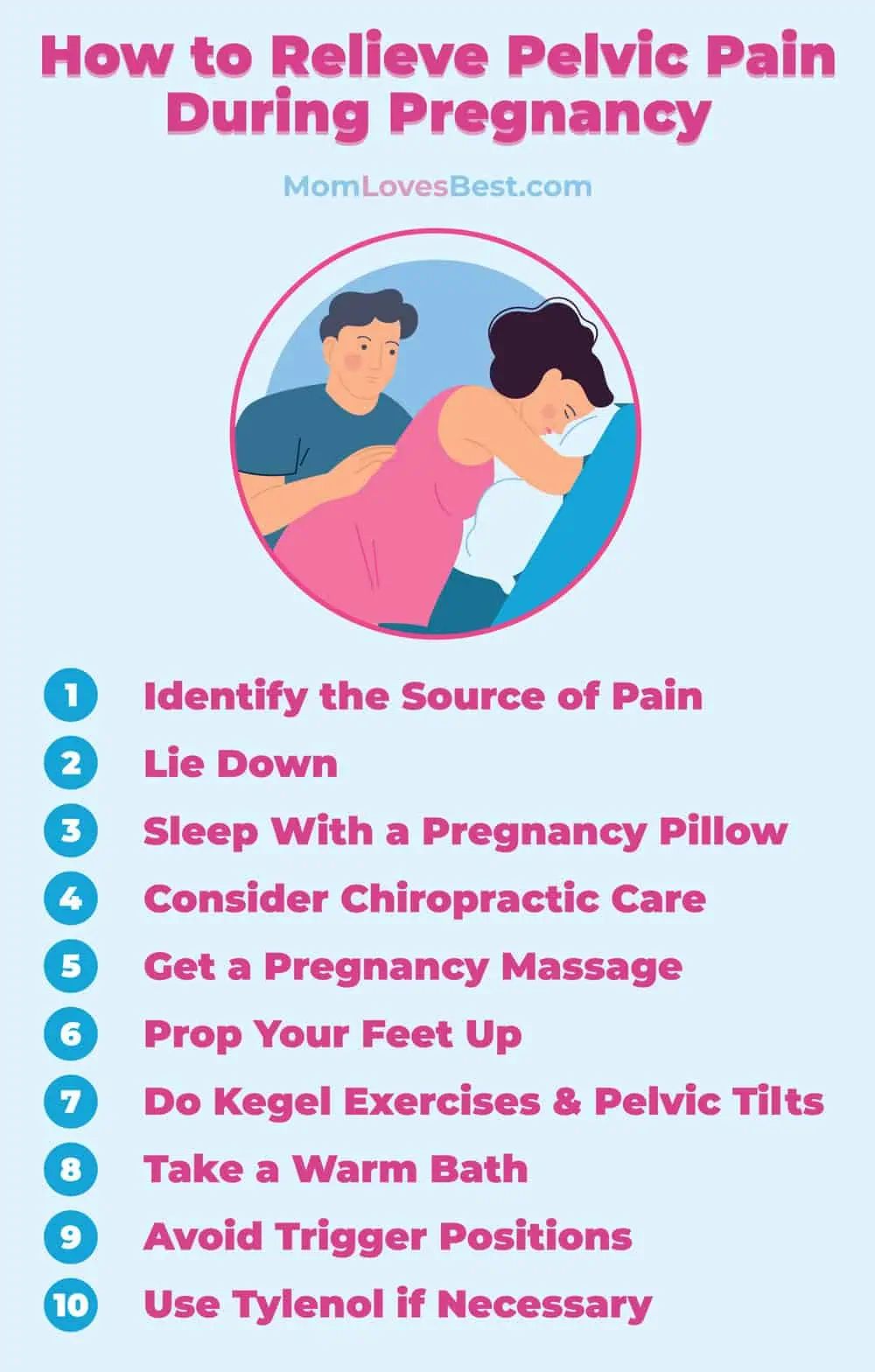Are you pregnant and experiencing pelvic discomfort? As your body grows, your muscles stretch, and your hormones shift, aches and pains are common.
We know from experience that pelvic pain can be particularly excruciating, causing some women to become nearly incapacitated during their final months of pregnancy. And even if they’re not painful, some sensations in the pelvis can make you worry that something is wrong.
Read on to learn more about what’s normal, what’s not, and how to deal with pelvic pain during pregnancy.
Key Takeaways
- Pelvic pain is common during pregnancy as the body adjusts to the added weight and changes in hormones.
- Pelvic pain can feel like pressure, sharp or stabbing pain, back pain, stretching or radiating pain.
- Pelvic pain is most common in mid-to-late pregnancy.
- Causes of pelvic pain include pelvic pressure, round ligament pain, lower back pain, Braxton Hicks contractions, and Symphysis Pubis Dysfunction.
- It is important to seek medical advice if pelvic pain persists or if it is accompanied by other symptoms such as bleeding, fever, or difficulty urinating.
What Is Pelvic Pain During Pregnancy?
Your pelvis plays a huge role in pregnancy. Not only does it help to support the added weight of a baby as your belly grows larger, but it also has to separate to allow your baby to pass through during childbirth.
Apart from the actual pelvic bones, there’s also a ton going on in your lower abdominal and pelvic region. Between the uterus placement, your baby’s positioning, and the stretching of muscles, ligaments, and skin, it’s common for women to experience strange sensations in this region during pregnancy.
Pelvic pain can feel like a number of sensations:
- Pressure.
- Sharp, stabbing pain.
- Back pain.
- Stretching.
- Radiating pain.
- General soreness.
When Does Pelvic Pain Occur?
Pelvic pain is most common in mid-to-late pregnancy, as that is when the baby is the largest, causing the most pressure on a woman’s body. However, some types of pelvic pain occur early in pregnancy.
What Causes Pelvic Pain During Pregnancy?
There are many causes of pelvic pain and discomfort during pregnancy.
These are some of the most common:
- Pelvic pressure: Because of the baby’s weight pushing down on your pelvis, you may feel pressure as your baby grows. This pressure is generally most prevalent when you’re standing or walking and is relieved when you lie down.
- Round ligament pain: As your belly grows, your abdominal muscles stretch. One particular ligament that runs along your side tends to be stretched and pulled by your uterus and causes discomfort to some women. While this typically feels like severe stretching, it can also present as sharp pains. It may hurt when you’re getting up from a sitting position or while walking and can be relieved by lying down on the uncomfortable side. These pains usually subside by 24 weeks (1). Round ligament pain is usually worse with the second and subsequent pregnancies.
- Lower back pain: Sometimes, it’s hard to isolate where your discomfort is coming from, and while you think it’s in your lower pelvic region, it’s actually radiating from your lower back. Lower back pain is commonly caused by the added weight and pressure associated with pregnancy but can also be due to constipation, a urinary tract infection, or kidney stones.
- Braxton-Hicks contractions: Contractions feel different for every woman, but many feel a sensation in their pelvic area. Braxton-Hicks contractions are normal and are basically the uterus warming up for labor. Braxton-Hicks contractions are only felt in the front of your body. A true pregnancy contraction begins in the back and moves toward your stomach. Braxton-Hicks contractions do not cause labor to progress and should stop if you change positions. If you’re standing up and having contractions and aren’t sure if they’re the real thing, lie down on your couch for a while to see if they stop. Pregnant women can also empty their bladder and drink a large glass of water before lying down, as having a full bladder and being dehydrated can also cause Braxton-Hicks contractions.
- Symphysis Pubis Dysfunction: Symphysis Pubis Dysfunction (SPD) is a painful condition in which the pubic bone — which is designed to separate during childbirth to allow your baby through the birth canal — begins to loosen and separate prematurely. It does this because of the pregnancy hormone relaxin, which causes your muscles and ligaments to relax (2). This can cause sharp, unexpected pains in the pubic bone or a tearing sensation in the middle of the lower pelvis. While some women may experience mild discomfort at all times, most feel a shooting sensation when they’re in a triggering position, such as separating the legs to roll over at night or standing on one leg while getting dressed.
While true separation of the symphysis pubis is not common, it can occur in late pregnancy and can be debilitating. I have had patients with SPD who needed to use a pelvic belt to “hold” their symphysis pubis together while walking, which helped their symptoms.Editor's Note:
Jennifer Schlette, MSN, RN
When Should I See My Doctor for Pelvic Pain?
If your pelvic pain is ever accompanied by bleeding, see your doctor immediately.
If you have severe pelvic pain during your first trimester, it is important to notify your doctor. While some pelvic pressure, cramping, or discomfort is normal, most pelvic pain occurs in mid-to-late pregnancy.
In early pregnancy, sudden and severe pelvic pain could signal miscarriage or ectopic pregnancy.
Remember
Your doctor will check you for these conditions to rule them out, so even though you’ll have to deal with ongoing pelvic pain, at least you won’t have to worry about it being a symptom of a serious condition.
What to Avoid When Treating Pelvic Pain
As wonderful as a heating pad sounds on your aching body, avoid them if possible as they’re not entirely safe for use during pregnancy. If you do opt for a heating pad, make sure the heat is not directly against your skin, you use a low-temperature setting, and you don’t use it for more than 20 minutes (3).
You should also skip the hot tub for similar concerns about overheating.
Finally, avoid pain relievers such as aspirin and ibuprofen, along with muscle rub treatments, as they contain aspirin which can be absorbed into your body through the skin.
Aspirin and ibuprofen are not safe during pregnancy due to the risk of bleeding they pose. Tylenol (acetaminophen), however, is viewed as the only safe over-the-counter pain reliever in pregnancy.
Editor's Note:
Jennifer Schlette, MSN, RNHow to Relieve Pelvic Pain During Pregnancy
If you’re experiencing pelvic pain during pregnancy, you can do the following to help relieve your discomfort:
1. Identify the Source of Your Pain.
As much as possible, try to isolate the discomfort you are feeling. Does it feel like pressure? Stretching? Sharp, stabbing pains?
Although pain can radiate from one part of the body to another, try to figure out where your primary discomfort is coming from, as that will help you determine the best course of treatment.
2. Lie Down.
Not only can this relieve your symptoms, but it can also help you to determine the source of your pelvic pain. If you are experiencing round ligament pain, laying on the painful side can help relieve it.
If you lie down but experience sharp pubic pain when rolling over, you may be able to identify that you are suffering from SPD. If you are experiencing pelvic pressure, lying down should help relieve it.
Keep In Mind
3. Sleep With a Pregnancy Pillow.
A pregnancy pillow can help relieve pressure on your pelvis by propping up your knees and keeping your hips parallel. When you sleep on your side with your knees together, your top leg drags your hip down and can cause hip and pelvic discomfort.
Sleeping with a pregnancy pillow between your knees can help relieve this pressure. If you don’t have a pregnancy pillow, a regular pillow will work just fine.
4. Consider Chiropractic Care.
Chiropractic care is safe during pregnancy, and while all chiropractors receive training in prenatal chiropractic care, some choose to go through additional specialized training (4). To ensure you select a chiropractor who can help diagnose and treat your pelvic pain, speak with them about your specific ailments before any adjustments. Ask about their credentials or ask your OB/GYN if they have a specific chiropractor they recommend to their patients.
5. Get a Pregnancy Massage.
Massage can help with pelvic pain caused by muscle strain. Opt for a massage therapist who specializes in pregnancy massage.
Some have special tables to accommodate a large belly, while others use non-traditional positions to perform the massage.
Remember
6. Prop Your Feet Up.
Sometimes simply sitting can put undue stress on your back, hips, and pelvis. Place a step stool under your desk at work to raise your feet and bring your knees back into alignment with your hips, keeping them from pulling down your lower back and pelvis.
7. Do Kegel Exercises and Pelvic Tilts.
Kegel exercises and pelvic tilts strengthen the pelvic muscles, which may be uncomfortable due to weakening. Kegel exercises involve clenching and releasing your Kegel muscles, the same muscles you would use to stop your urine mid-stream.
Tighten and release the muscles 50 times in a row three times a day to strengthen your Kegel muscles.
While Kegel exercises work internal muscles, pelvic tilts work external muscles. There are several ways to do them, and you can choose the one you’d like based on what is most comfortable.
You can do pelvic tilts while standing.
You can do them on all fours.
Or, you can do them lying on your back. However, since you’re pregnant, you should not lie on your back for an extended period.
8. Take a Warm Bath.
A warm, not hot bath can be soothing and relaxing, but the key to doing it safely is to ensure the water temperature is not above 100 degrees. An elevated body temperature poses a risk for your baby, so if you’re soaking to soothe your aching body, do so in water that’s not hot enough to raise your core body temperature.
9. Avoid Trigger Positions.
If your pelvic pain is due to PSD, you’ll find certain positions predictably trigger shooting pain. For most women, this occurs when separating the legs — like when you’re getting dressed or turning over in bed — or flexing muscles in the upper thigh — like pushing or pulling motions.
Avoid strenuous activity, and try to modify your movements during trigger activities to avoid causing pain.
10. Use Tylenol if Necessary.
Sometimes, dull and achy pelvic pain is not relieved by changes in position and persists no matter what you do. If this is the case, you may need to consider medical pain relief.
Tylenol, the brand name of the medicine acetaminophen, is considered safe for use during pregnancy. However, overuse has been linked to liver damage (5). Use it sparingly as needed, and make sure you communicate with your doctor about how much and how often you take it.
FAQs
The Bottom Line
Pelvic pain and discomfort are pretty common during pregnancy, thanks to the myriad of changes happening in your body. Between your shifted center of gravity, increased weight, added hormones, and stretching muscles, you may feel any number of strange or even painful sensations in your pelvic region.













